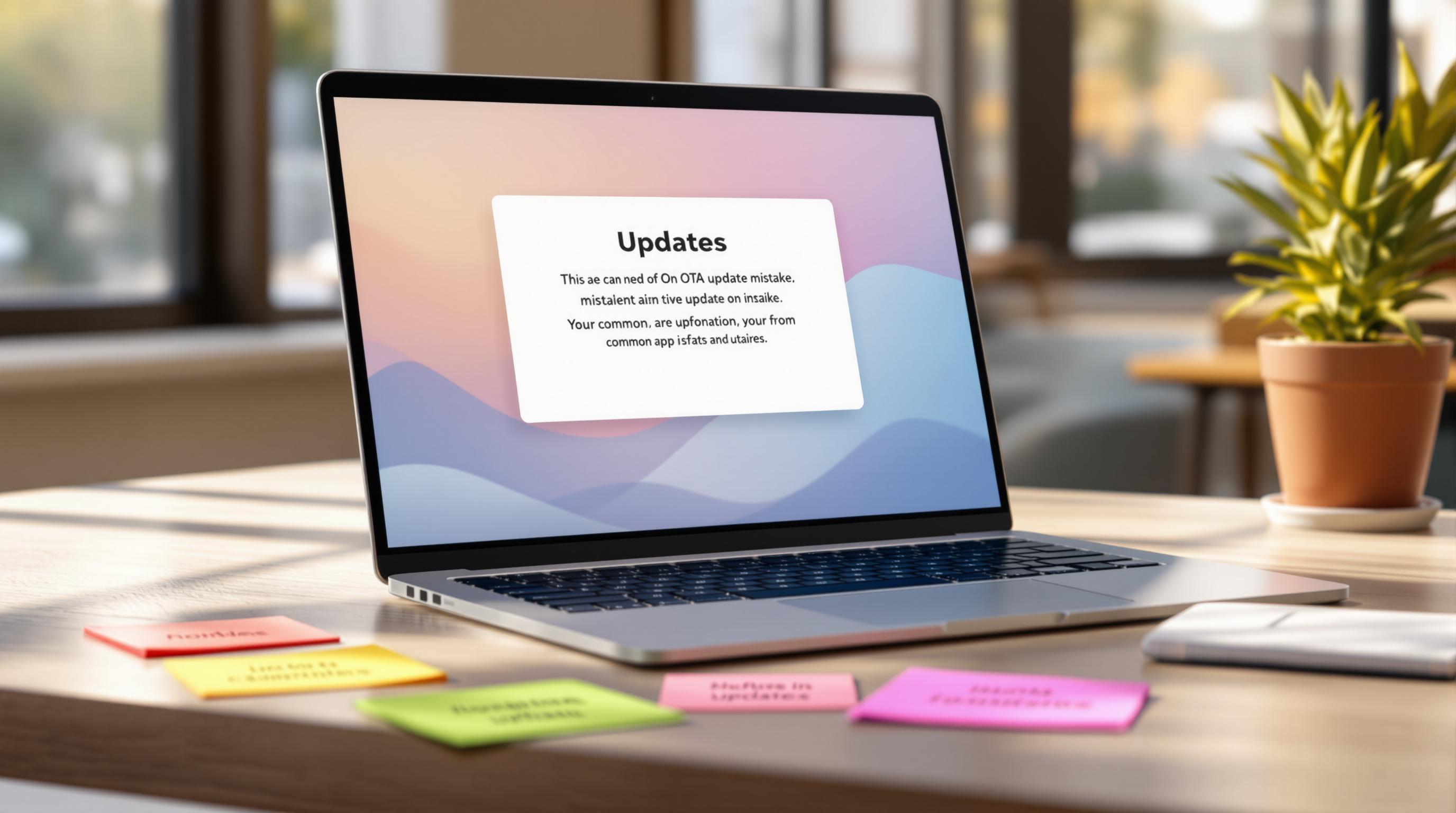Secure OTA updates for Capacitor apps are essential to protect users and their data. Here’s how to ensure safe updates:
- Integrity Checks: Use cryptographic hashes and digital signatures to confirm updates are unaltered.
- Common Threats: Prevent interception, spoofing, and tampering with HTTPS, digital signatures, and checksums.
- Capgo Integration: Simplify secure updates with Capgo’s encryption, real-time verification, and rollback features.
- Key Security Practices:
- Enforce HTTPS for secure communication.
- Use mutual TLS authentication for update requests.
- Sign update packages and verify them with checksums.
- Store keys securely using iOS Keychain or Android Keystore.
Quick Tip: Automate rollback for failed updates and keep users informed during issues to maintain trust.
This article dives into setting up a secure OTA infrastructure, cryptographic methods, and practical tools like Capgo to streamline the process.
Related video from YouTube
Secure OTA Update Infrastructure
Build a reliable OTA (Over-The-Air) update system for Capacitor apps by incorporating HTTPS, strong authentication, and real-time update tools.
HTTPS Setup for Updates
Using HTTPS is crucial for encrypting update transmissions. Key security measures include:
| Security Component | Implementation Detail | Purpose |
|---|---|---|
| SSL/TLS Certificate | Obtain from a trusted Certificate Authority (CA) | Secures data during transmission |
| Server Configuration | Enforce strict HTTPS usage | Protects against downgrade attacks |
| Certificate Pinning | Validate SHA-256 fingerprint | Confirms server identity |
Ensure your Capacitor app only accepts HTTPS connections for update requests. This step prevents data interception and tampering, forming the base for secure authentication.
Update Request Authentication
TLS (Transport Layer Security) mutual authentication ensures both the client and server verify each other’s identity. All HTTP communications for updates should include strict authentication and authorization checks [2]. These protocols enhance the security provided by HTTPS, creating a layered defense.
Using Capgo for Updates

Capgo offers a streamlined and secure solution for managing OTA updates. With over 23.5 million updates delivered across 750 production apps, Capgo provides:
- End-to-end encryption for authorized users
- Compliance with Apple and Google platform rules
- Real-time verification to ensure update integrity
To get started, install the Capgo plugin using npx @capgo/cli init. This enables automatic verification of updates when the app starts. For iOS, Capgo includes a custom Dart interpreter to meet platform-specific requirements [3].
sbb-itb-f9944d2
Cryptographic Security Methods
Secure OTA updates in Capacitor apps by implementing strong cryptographic practices.
Key Management
Effective key management is critical. Use a Key Management Service (KMS) to handle the generation, storage, distribution, and monitoring of encryption keys.
| Key Management Phase | Implementation Requirements | Security Considerations |
|---|---|---|
| Generation | Use a cryptographically secure TRNG | Ensure a hardware-based entropy source |
| Storage | Utilize encrypted backup systems | Maintain secure key isolation |
| Distribution | Apply access control mechanisms | Enforce role-based permissions |
| Monitoring | Enable real-time access tracking | Set up automated alerts |
For client-side key storage, rely on secure platform-specific tools like iOS Keychain Services and Android Keystore APIs. Once your keys are securely stored, sign your update packages to confirm their authenticity.
Update Package Signing
-
Package Preparation
Prepare the update bundle by including your production Capacitor build output, typically located in the “dist/” or “www/” directory. The package should include:
index.html- Bundled JavaScript files
- CSS resources
- Other necessary web assets
-
Signing Process
Use Capacitor’s
publicKeyconfiguration to enable end-to-end encryption. Keep the zip file unencrypted to ensure smooth unpacking during updates.
Update Verification Steps
To ensure the integrity of signed updates, follow these verification steps:
| Verification Step | Purpose | Implementation |
|---|---|---|
| Bundle Integrity | Ensure package completeness and verify the source | Validate required files and cryptographic signatures |
| Version Control | Prevent downgrade attacks | Compare version numbers with the latest deployed version |
For added security, implement a server-side verification system to manage sensitive operations involving secret keys. This aligns with best practices and recommendations from NIST for maintaining the integrity of update systems.
Failed Update Management
Managing failures effectively after verifying update integrity is crucial for maintaining system reliability and user trust.
Update Rollback Steps
Set up an automated rollback system to handle situations where integrity checks fail. Capgo’s automated reversion tools can help ensure your system stays stable during such events.
| Phase | Action | Verification |
|---|---|---|
| Pre-rollback | Verify backup version integrity | Check cryptographic signatures |
| Execution | Restore previous working version | Confirm successful restoration |
| Post-rollback | Validate app functionality | Run critical path tests |
Here’s how you can configure your Capacitor updater with suitable timeout settings for smoother rollbacks:
{ appReadyTimeout: 10000, responseTimeout: 15000, autoDeleteFailed: true}Error Tracking System
Capacitor’s built-in event listeners are handy for tracking errors during updates. Use them to monitor and log issues effectively:
- Monitor events like
updateFailedanddownloadFailed - Log version details and failure causes
- Identify recurring issues by analyzing patterns
This approach helps you pinpoint problems and prepares you to communicate clearly with users during update failures.
User Communication Guide
Keeping users informed during update failures minimizes frustration and reduces support tickets. Here’s a guide for effective communication:
| Timing | Message Content | Channel |
|---|---|---|
| Pre-update | Scheduled maintenance notice | In-app notification |
| During failure | Status and resolution time | Status bar updates |
| Post-incident | Issue resolution confirmation | Push notification |
Key tips for communication:
- Notify users immediately with a simple explanation and an estimated resolution time.
- Provide ongoing updates through the system status bar.
- Send a final confirmation once the issue is resolved, including instructions for version verification.
“A well-thought-out rollback plan is a testament to the maturity of an organization’s risk management and operational readiness.” - Jos Accapadi, MBA, LinkedIn article
Security Guidelines Summary
This section brings together key security practices discussed earlier.
Main Security Points
Effective OTA security relies on multiple layers of protection. Techniques like SSL pinning and storing certificates on the device help prevent man-in-the-middle attacks [4].
| Security Layer | Implementation | Verification Method |
|---|---|---|
| Communication | Enforce HTTPS | SSL certificate validation |
| File Integrity | Generate checksums | checksum.json verification |
| Authentication | Request signing | Public key validation |
| Update Protection | SSL pinning | Certificate matching |
Capgo Integration
Capgo’s latest release (v7.0.23, February 2025) introduces improved security for managing packages across platforms. By integrating Capgo, you can streamline secure update processes. The platform uses end-to-end encryption and aligns with app store security requirements.
Here’s an example of a secure configuration for your project:
{ autoUpdate: true, updateUrl: "https://api.capgo.app/updates", autoDeleteFailed: true, responseTimeout: 15000}Developer Checklist
OWASP highlights insecure communication as one of the biggest risks in mobile development, emphasizing the importance of robust security measures [4].
-
Authentication and Verification
- Use Capgo’s token system for secure request authentication.
- Create a
checksum.jsonfile during the build process to verify both individual components and the entire package [1]. - Ensure credentials are stored securely.
-
Monitoring and Configuration
- Enable error tracking to catch issues early.
- Configure automatic rollbacks for failed updates.
- Use Capgo’s analytics dashboard to monitor update performance and statistics.
Following these practices will help you maintain secure OTA updates for Capacitor apps.




